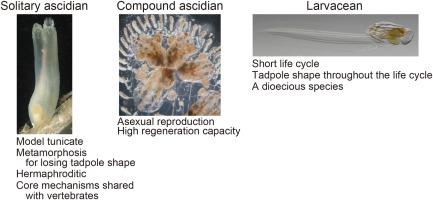Germ cell formation and reproduction in tunicates
IF 2.1
3区 生物学
Q2 DEVELOPMENTAL BIOLOGY
引用次数: 0
Abstract
Because tunicates are the closest living relatives of vertebrates within the phylum Chordata, understanding the mechanisms of tunicate germ cell formation is essential to infer this process in ancestral chordates. Vasa-localization to primordial germ cells (PGCs), PGC formation biased to the posterior side of embryos, and transcriptional silencing by phosphorylation of RNA polymerase II are the core PGC-forming events inherited from the shared ancestor of protostomes and deuterostomes. Neuropeptide- and peptidase-mediated regulations of oocyte maturation are examples of mechanisms observed in both vertebrates and tunicates. However, the pathways that activate and regulate these mechanisms, such as the hypothalamus–pituitary–gonad axis, are not always conserved between tunicates and vertebrates, suggesting that these animals achieved the same end-products via different molecular mechanisms. Tunicates are divided into the classes Ascidiacea, Thaliacea, and Larvacea, each of which exhibits specific characteristics in germ cell formation. Some ascidians form colonies of interconnected zooids, each having regenerative capacity sufficient to regrow the entire body, including gametes, from a tiny body piece. Larvaceans maintain their tadpole shape throughout their very short life cycle: they manage to complete their gamete formation using small gene sets encoded in the shortest genomes yet observed among non-parasitic animals. These group-specific characteristics are likely to reflect different strategies for ensuring survival in the respective environments.

被囊动物生殖细胞的形成和繁殖
由于被囊动物是脊索动物门中脊椎动物的近亲,了解被囊动物生殖细胞形成的机制对于推断祖先脊索动物的这一过程至关重要。vasa定位于原始生殖细胞(PGCs), PGC形成偏向胚胎后部,以及RNA聚合酶II磷酸化导致转录沉默是原口动物和后口动物共同祖先遗传的核心PGC形成事件。神经肽和多肽酶介导的卵母细胞成熟调节是在脊椎动物和被囊动物中观察到的机制的例子。然而,激活和调节这些机制的途径,如下丘脑-垂体-性腺轴,在被囊动物和脊椎动物之间并不总是保守的,这表明这些动物通过不同的分子机制获得相同的最终产物。被囊动物分为海鞘类、海鞘类和幼虫类,每一种在生殖细胞形成方面都表现出特定的特征。一些海鞘形成相互联系的动物群落,每一个都有足够的再生能力,可以从一个很小的身体部位再生整个身体,包括配子。幼虫在其非常短的生命周期中保持蝌蚪形状:它们设法通过在非寄生动物中观察到的最短基因组中编码的小基因集来完成配子的形成。这些群体特有的特征可能反映了在各自环境中确保生存的不同策略。
本文章由计算机程序翻译,如有差异,请以英文原文为准。
求助全文
约1分钟内获得全文
求助全文
来源期刊

Developmental biology
生物-发育生物学
CiteScore
5.30
自引率
3.70%
发文量
182
审稿时长
1.5 months
期刊介绍:
Developmental Biology (DB) publishes original research on mechanisms of development, differentiation, and growth in animals and plants at the molecular, cellular, genetic and evolutionary levels. Areas of particular emphasis include transcriptional control mechanisms, embryonic patterning, cell-cell interactions, growth factors and signal transduction, and regulatory hierarchies in developing plants and animals.
 求助内容:
求助内容: 应助结果提醒方式:
应助结果提醒方式:


